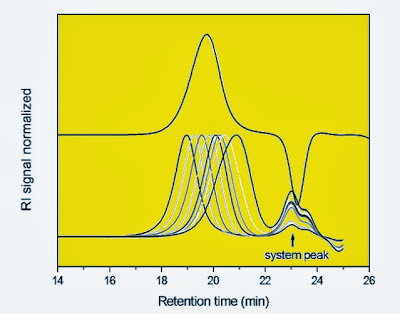The main separation modes of liquid chromatography were described in previous posts entitled "Selection of the Liquid Chromatographic (LC) / HPLC Separation Mode" and "Which are the main liquid chromatography separation modes? / Liquid-Liquid Chromatography (LLC)".
Another separation mode in Liquid Chromatography is steric exclusion chromatography (SEC).
In steric exclusion chromatography (SEC) there is no interaction between the sample compounds and the column packing material. Instead, molecules selectively diffuse into and out of the pores of a porous medium.
The degree of retention depends on
the size of the solute molecule relative to the size of the pore. Small
molecules will pass through the smaller ports, intermediate size molecules will
pass through some of the pores and be excluded from others while very large
molecules may by completely excluded.
In a steric exclusion system, the
larger molecules are retained less and therefore will elute from the column
before the smaller molecules (Fig. 1a).
The SEC technique is used by 15% of chromatographers, mainly for polymer characterization and for proteins (human serum proteins, DNA, crude oils). Steric exclusion chromatography has found very wide application for separations in the life science and biochemical areas. Since compounds in most life systems are water-soluble and of high molecular weight, this form of chromatography is very applicable.
The SEC technique is used by 15% of chromatographers, mainly for polymer characterization and for proteins (human serum proteins, DNA, crude oils). Steric exclusion chromatography has found very wide application for separations in the life science and biochemical areas. Since compounds in most life systems are water-soluble and of high molecular weight, this form of chromatography is very applicable.
In Fig. 1b a SEC
analysis of a polymer and the obtained fractions are shown after separation.
There are two
modes of SEC:
Non-aqueous SEC [sometimes termed Gel Permeation
Chromatography (GPC)] and aqueous SEC [sometimes
referred to an Gel Filtration Chromatography (GFC)].


No comments:
Post a Comment